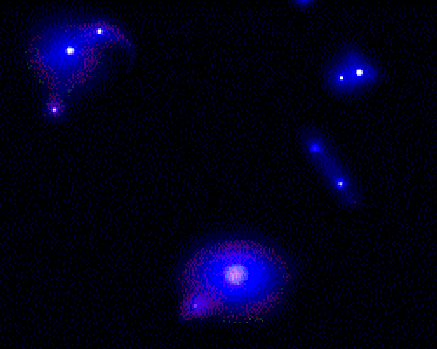Astronomy Picture of the Day
Discover the cosmos!
Each day a different image or photograph of our fascinating universe is
featured, along with a brief explanation written by a professional
astronomer.
September 7, 1996

Two Billion Years After the Big Bang
Credit:
S. Pascarelle
(Arizona State U.)
Explanation:
What did the
universe look like two billion years after the
Big Bang? According to
this computer model, the universe was filled with irregular looking objects like the ones shown above. The simulation then predicts that these blobs of stars and gas collide to form galaxies more similar to the ones we see today. In fact, this simulation bears much resemblance to
recent pictures of distant galaxies taken by the
Hubble Space Telescope.
Galaxy formation is a complex phenomena which only now is becoming understood. Did most galaxies form 5 billion years ago - or 10 billion? Did galaxies fragment from larger sheets of matter, or are they conglomerations of many smaller clumps? Simulations like this one are helping to determine the answer.
Tomorrow's picture: Volcano Euboea Fluctus On Io
| Archive
| Index
| Search
| Glossary
| Education
| About APOD |
Authors & editors:
Robert Nemiroff
(MTU) &
Jerry
Bonnell (USRA).
NASA Technical Rep.:
Sherri
Calvo.
Specific rights apply.
A service of:
LHEA
at
NASA/
GSFC
